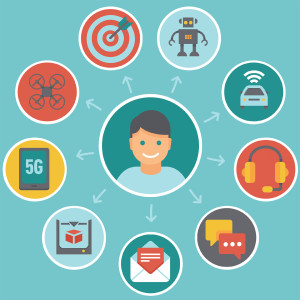In business, the customer’s needs are paramount. But, says Antony Slumbers, founder of software firm Estates Today, there’s no point knowing what your customer wants if you don’t know about the tech that will affect their decisions

A successful start-up identifies a need and develops a means of fulfilling it. Once beyond the start-up stage, however, it is all too easy to slip from this mindset of putting the customer’s needs first. But if you fail to keep up with your customers’ needs and desires, the only way is down.
Customer needs and desires change over time, often because of changes in technology. For example, satellite phone company Iridium spent $5.2bn (£3.7bn) building a global network to support its specialist phones, only to find that by the time it had done so, the customer demand that had existed at start-up had disappeared as cell-based mobile phones rendered the need for satellite phones almost redundant.
People love to take photos, and digital trashed the film industry; but digital cameras were in turn trashed by their incorporation into smartphones. The best camera is the one you have with you, and everyone has a smartphone.
So, while looking through your customers’ eyes is vital, it must be done with a view to how technology is advancing, and how new capabilities might alter the landscape.
For each industry there are certain technologies we can see coming down the tracks that might do this, and in most cases it is only a matter of timing as to when the major impact will manifest itself.
And in line with the 50-year-old Moore’s Law (which states that processing power for a particular cost doubles every two years) many of these technologies are developing at an exponential rate.
So what are the technologies on which we need to keep an eagle eye?
• 3D Printing When the International Space Station uses 3D printing to supply the crew with a particular type of wrench, you start to see the potential: mass customisation, manufacturing on demand (no warehouses), and repatriation of manufacturing facilities to developed countries.
• Drones are ever more intelligent and dropping in price. Expect to see delivery by drone as well as ubiquity for site inspections, restricted-space photography, marketing videos, 3D mapping, thermal imagery and aerial photography.
• Lidar The technology instrumental in enabling autonomous cars is crashing in cost and the impact of this fast-growing industry (every major car brand is spending billions in this field) will be huge. Imagine city centres with only self-driving cars. How we all use space could change dramatically.
• Industrial robots are becoming more intelligent, bigger, smaller and less expensive. Hadrian is a robotic bricklayer that can build a domestic-size house in two days. Automating construction has to be a major growth area.
• 5G The Japanese are aiming to have 5G available in 2018 for the Winter Olympics, but 2020 is probably when we will see this technology start to grow. With broadband speeds in the multi-gigabit range, 5G will be enormously disruptive. The virtual office will be enabled as we will be able to video chat with multiple people in real time, at scale, in high definition and with no lag in connectivity. Will the office really be dead this time around?
• Smartphones/AI The iPhone is eight years old this year and the present version is as powerful as a 1990 supercomputer. Moreover, because of increasing bandwidth, each of us is effectively plugged in to the vast computational power of data centres run by the likes of Google, Apple, Amazon and Facebook. Couple this with the dramatic rise of AI and the range of contextually aware, real time data and information that is becoming available to us is staggering. Each of us will become hooked on having available just that piece of information we need whenever and wherever we need it.
Here then is the future, or at least a good chunk of it.
Each of the above technologies are either with us already, and becoming faster/better/cheaper, or will be within a few years. Going back to “what does our customer want”, how then do we leverage the tools at our disposal?
Break everything down to touchpoints: when, where and how does your customer (and partners or suppliers) interact with your business? Could these touchpoints work better? If you were your own customer, what do you think you would want in terms of how you are serviced? Can your customers get everything they need from you, on demand? How hard is it to give you money? How hard is it to get support, or information? Do your customers want to hear from you more? Or less? And in what format? What is convenient for them?
Think of these touchpoints, these interactions. List them. Then try to digitise them. Does that improve them? And where’s the value? How can you provide the most value?
When you break your own skills down into their component parts and then think of them in connection with the technology available to us now or in the near future, different patterns will almost certainly develop to the way your business runs today. Maybe your investment strategies will change to take account of how you now envisage demand will change. Perhaps you will realise that you have valuable knowledge that was historically too difficult to monetise but that you could do so with an online, on-demand platform. Or maybe you can see how you could provide more support to your customers, in real time and at scale, without upping your costs in doing so.
It’s all really a case of stepping back, seeing the overall landscape, developing a sense of situational awareness of where your business stands within your industry or profession, and then zooming in to each product or service you provide and seeing how you can use technology to give your customer more of what they really want, as opposed to what they accept today.
And before you say “all very well, but we are in a people business” that is exactly the point. It is by combining the capabilities of modern technology with the empathy, design, intuition and imagination of humans that great businesses are going to be built. Humanity, after all, is the killer app in the digital age.











